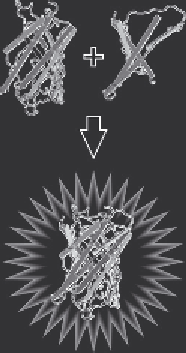Biology Reference
In-Depth Information
be used to monitor bimolecular or multimolecular interactions. After the
original demonstration of the principle of fragment-based monitoring
of protein-protein interaction, which employed fragments of ubiquitin,
63
fragments of a number of proteins, including
b
-galactosidase, dihydrofolate
reductase, autofluorescent proteins,
b
-lactamase, and luciferases, have also
been used.
64-71
Of the available methods for the detection of protein interactions based on
protein fragment association, the use of fragments of fluorescent proteins known
as “bimolecular fluorescence complementation” (BiFC) might be the most
widely used.
72,73
The BiFC assay is based on lessons learned from circular
permutation of fluorescent proteins (see
Section 2.3
); in this assay, an
interaction between proteins fused to nonfluorescent fragments of fluorescent
protein facilitates fluorescence emission through the reconstitution of the
fragments (
Fig. 8.2A
).
66
When used with a fluorescence microscope, the
BiFC assay enables visualization of the intracellular distribution of protein
interactions without the addition of other exogenous agents as substrates.
BiFC was first used to monitor the noncovalent association of antiparallel
A
B
N-terminus
C-terminus
Figure 8.2 Schematic representation of BiFC. (A) Although the N- or C-terminal frag-
ments of fluorescent proteins are not fluorescent, they emit the proper fluorescence
upon reconstitution. (B) Multicolor BiFC. As a result of the interaction between two frag-
ments of different fluorescent proteins, the fluorescence spectrum is determined by the
N-terminal fragment. This can be used to analyze the stoichiometry of the interaction.


Search WWH ::

Custom Search